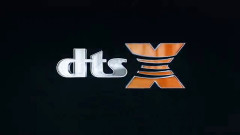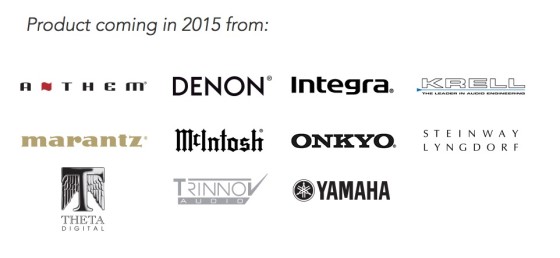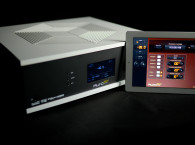 Just prior to the opening of the 2015 NAB Show in Las Vegas, where demonstrations of the upcoming ATSC 3.0 digital television standard are being promoted, DTS has unveiled further details about DTS:X, its own object-based, immersive audio technology, competing directly with Dolby Atmos and the MPEG-H formats under evaluation.
Just prior to the opening of the 2015 NAB Show in Las Vegas, where demonstrations of the upcoming ATSC 3.0 digital television standard are being promoted, DTS has unveiled further details about DTS:X, its own object-based, immersive audio technology, competing directly with Dolby Atmos and the MPEG-H formats under evaluation.For more on ATSC 3.0 competing audio proposals, click here.
But while the new immersive audio proposals are being considered for upcoming digital TV standards, DTS confirms that DTS:X was also designed as a next-generation, object-based, multi-dimensional immersive audio technology, intended to be licensed already for the cinema and home theater markets, allowing for numerous customization options.
Like any other object-based format, DTS:X is not tied to prescribed speaker configurations or a specific number of audio channels, unlike existing surround sound systems. DTS:X also adapts to the viewing environment, allowing for a flexible speaker configuration that best fits the viewing space. The company states that DTS:X conveys more accurately “the fluid movement of sound to create a richer entertainment soundscape than has previously been possible by moving sound objects to and through specific locations within - in front of, behind, above and beside the audience, precisely where the mixer placed them.”
“DTS:X is built on the foundation of providing an open, adaptable solution for content creators, cinemas and homes to fulfill our goal of bringing immersive audio to as many people around the world as possible,” says Jon Kirchner, chairman and CEO of DTS, Inc. “Until recently, sound in movie theaters and in our homes has been dictated by a standardized speaker layout. Through the use of object-based audio, DTS:X is able to scale immersive soundtrack presentations across a wide range of playback systems, from efficient to extravagant, while staying true to the content creator’s vision. This approach delivers the most authentic three-dimensional audio experience ever, making the audience feel as if they are in the center of the action.”
 DTS:X in Cinema Sound
DTS:X in Cinema SoundSince 1993, when DTS introduced its own surround sound format, delivering “Jurassic Park’s” 5.1-channel soundtrack on CD-ROM, which was synchronized to the picture using a time code printed on the film, the company always competed directly with Dolby on the cinema market. Twenty-two years later, DTS:X is no longer limited to channels or tied to a speaker layout and can now be delivered as part of the Digital Cinema Package (the standard file format delivery for digital cinema in theaters).
The foundation of DTS:X is MDA (Multi-Dimensional Audio), DTS’ license fee-free, open platform for creation of object-based immersive audio which has been submitted to the SMPTE for standardization. Early research on MDA was carried by SRS Labs (acquired by DTS in 2012) as a way to translate objected-based audio in a tridimensional space, envisaging applications for games and cinema. The solution was later proposed as an open-source format with contributions and direct support from DTS, QSC, Doremi, USL (Ultra-Stereo Laboratories), Auro Technologies, Barco, film studios and exhibitors.
As DTS argues, MDA gives movie studios unprecedented control over the specific placement, movement and volume of sound objects, allowing sound engineers to “mix once” for both immersive and conventional cinemas in a combined object- and channel-based audio format, allowing content to be easily distributed beyond the theater for streaming, broadcast, optical media and more.
“MDA is DTS’ license fee-free contribution to the professional audio community for mixing and storage of immersive audio content,” says Kirchner. “MDA fits perfectly within today’s production workflow, and a combination of MDA and DTS:X provides a complete end-to-end workflow, from creation to exhibition.”

DTS intends to license DTS:X technology in cinemas and will supervise the installation of DTS:X-approved equipment and recommended speaker installation guidelines, much in line with what Dolby is doing with its rival format, Dolby Atmos.
To ensure quality and provide flexibility within the DTS:X program, DTS has partnered with industry-leading server, sound rendering and processing companies. GDC Technology, QSC and USL, have developed and made available DTS:X-ready components that process and render MDA files.
GDC Technology will develop, manufacture and sell digital cinema servers and provide a comprehensive suite of digital cinema products, services and solutions for exhibitors and distributors. QSC Audio will supply professional audio systems for production and cinema sound worldwide. USL is also engaged in the design, manufacture, and sale of motion picture audio equipment and sound processors.
GDC Technology and Carmike Cinemas are initial partners integrating DTS:X into theaters in the US and abroad. GDC Technology boasts the largest installed base of digital cinema servers in the Asia-Pacific region, and the second largest, globally. DTS also confirmed that GDC is the worldwide DTS:X certification agent with an exclusive in Asia. GDC will make MDA firmware updates available to theater owners over to its existing installed server base of more than 40,000 servers starting in May 2015.
GDC will provide DTS:X installation and certification for approximately 350 screens throughout Asia beginning in May 2015. “GDC is committed to offering state-of-the-art technology to its customers. We chose DTS:X because we believe it will transform the movie theater experience for audiences around the world,” said Dr. Man-Nang Chong, founder and CEO of GDC Technology. “Theater owners will appreciate the easy integration and flexible solutions that DTS:X offers as they upgrade their screens to this superior sound experience. Audiences win too. Because of the flexibility in speaker layout that DTS:X offers, immersive audio is now available to a larger number of theaters of all sizes than ever before.”
Carmike Cinemas, a leader in digital cinema and 3D cinema deployments and one of the largest motion picture exhibitors in the US, will upgrade selected theaters to DTS:X beginning in Spring 2015. “We believe in the open platform philosophy of DTS:X and are excited to be among the first theater partners to be onboard,” said Fred Van Noy, senior vice president and chief operating officer, Carmike Cinemas. “The flexibility of DTS:X allows us to deliver an immersive experience to a broader audience. We love the fact that DTS:X adapts not only to numerous room designs; it also enables us to continue working with our existing equipment provider, QSC.”
DTS is presently working with several major studios and mixing stages in Los Angeles, Northern California and Canada that are evaluating DTS:X. DTS:X content announcements will be made by the studios when ready, confirms DTS.
Home-theater Market
For the home-theater market, DTS will also license the DTS:X technology to audio electronics manufacturers. According to DTS, manufacturers representing nearly 90 percent of the home AVR and surround processor market will launch DTS:X-enabled products beginning in early Summer 2015, with additional manufacturer and model announcements to follow in the coming months.

Denon - AVR-X7200W available now / DTS:X firmware upgrade later in 2015
Integra - launching several models by Fall 2015
Marantz - AV8802 available now / DTS:X firmware upgrade later in 2015
Onkyo - launching several models by Fall 2015
Outlaw Audio – details to follow
Pioneer - details to follow
Steinway Lyngdorf - P200 Surround Sound Processor available Summer 2015 / DTS:X firmware upgrade in Fall 2015
Theta Digital - Casablanca IVa available Summer 2015
Trinnov Audio - Altitude32 available now / DTS:X firmware upgrade Summer 2015
Yamaha - launching DTS:X ready models in Fall 2015
DTS:X confirmed that development solutions are also available for AV receiver silicon platforms representing the majority of the DSP platform market share, including Cirrus Logic, Analog Devices and Texas Instruments.
According to technical details already revealed, DTS:X supports up to 96kHz sampling rates for object mixes and will support up to 192kHz for stereo and multi-channel mixes even though it will use lossless compression with dynamic bit allocation. “DTS:X supports lossless encoding for the highest audio quality possible. In situations where bitrate is of high concern, DTS:X can also operate in a high-quality lossy mode.”
As DTS explains, for home theater system owners, DTS:X provides personalization, flexibility and control for the most optimized listening experience possible. Since DTS:X builds upon existing DTS-HD Master Audio technology, it will be possible to provide backward compatibility with existing DTS bitstreams and speaker layouts. All features of DTS-HD Master Audio are supported and enable an immersive audio experience for older content.
The DTS:X content will be backward compatible with the DTS-HD decoder and a DTS:X decoder will support DVD, Blu-ray Disc (BD) and streaming media file formats. DTS:X will also be able to spatially reformat stereo, 5.1 or 7.1 content to take full advantage of all speakers in a surround system. The technology uses metadata-based spatial mapping to render the 3D sound image to actual speaker layouts. Since metadata objects are never lost, if the sound object is embedded, it can be extracted and used in the rendered experience, whatever the multichannel setup.
AVR owners with DTS:X will be able to control the volume of specific audio elements at home, such as increasing dialog volume to match their listening preferences. Dialog, as an object, can be lifted out from the background sounds when clarity and intelligibility are desired. Content creators have the choice to implement this feature in their mix and this will be a key feature also being promoted for digital television delivery.
According to the DTS presentation, because of the use of flexible speaker layouts and remapping technology, DTS:X will allow the placement of home theater speakers virtually anywhere. “The freedom of object-based audio enables optimized playback on a multitude of speaker layouts, with any number of speakers. The DTS speaker remapping engine supports any speaker configuration within a hemispherical layout based around the listening position in the room.”
New AVRs supporting DTS:X will be able to support up to 11.2 speaker output channels and content created for a specific speaker layout can be remapped for playout through a different layout. The AVR’s will also enable remapping of outputs to custom or OEM-defined speaker layouts, and remapping legacy content to new output configurations with support for 32 speaker locations (subject to each manufacturer’s product capabilities).
DTS also confirms that DTS:X content will be compatible with mobile devices using DTS Headphone:X technology to translate immersive surround sound through any ordinary pair of headphones.
www.dts.com/dtsx






